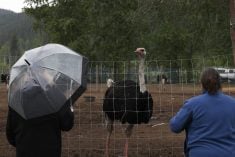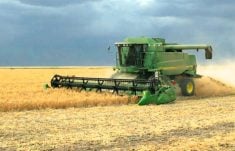CHICAGO (Reuters) — U.S. corn and soybean conditions were likely to get worse because of modest rainfall over the weekend and drier weather this week, an agricultural meteorologist said on Tuesday.
“I don’t think there will be any major improvements,” said John Dee, meteorologist for Global Weather Monitoring. “If anything, conditions will go down again.”
Chicago Board of Trade new-crop November soybean futures were up sharply in overnight Globex trade due to the threat to soy yields from harsh weather. Prices were expected to be 40 cents to 50 cents per bushel, or over three percent higher, at the reopen of CBOT trading on Tuesday.
Read Also

Arlene Dickinson says recent trip to Asia opened her eyes to new trade opportunities
Arlene Dickinson says Canada must take up decades-old suggestions to support the agriculture and food sectors
CBOT new-crop December corn was expected to gain from seven cents to eight cents per bushel at the reopen of trading on Tuesday.
At the close of overnight trading, December corn was up 6-1/2 cents per bushel and November soybeans was up 46 cents per bushel.
“Rains over the weekend were pretty good in the Missouri Valley but no so much elsewhere and that’s what’s driving soybeans higher today,” said Sterling Smith, futures specialist for Citigroup.
“It was unusually dry in late July through the month of August and there doesn’t appear to be any improvement yet,” Smith said.
Dee said rainfall in the U.S. Midwest crop belt was about as expected over the weekend, with showers of 0.20 inch to 0.80 inch noted and up to 1.00 inch or more in southern Indiana and Ohio.
“There is a pretty dry week ahead, though temperatures will be cooler this week,” Dee said.
Commodity Weather Group meteorologist Joel Widenor said the weekend rains were better than expected along the Iowa-Nebraska border but still missed many of the driest Midwest soybean areas.
“About 40 percent of the soybean belt remains severely dry and will continue to see yield losses mount as growth finishes up,” Widenor said.














